Good day, ladies and gentlemen. Thanks for tuning in to the quiz show Cowtown Trivia. Today our subject category is . . . Roosevelts.
Ready? Swell! Then let’s play Cowtown Trivia.
Our first question is: Who was the first President Roosevelt to visit Fort Worth?
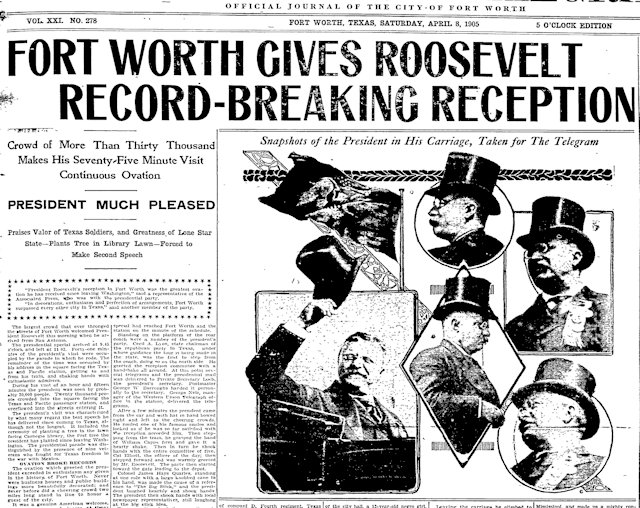 Teddy Roosevelt visited in 1905.
Teddy Roosevelt visited in 1905.
Who was the first ex-President Roosevelt to visit Fort Worth?
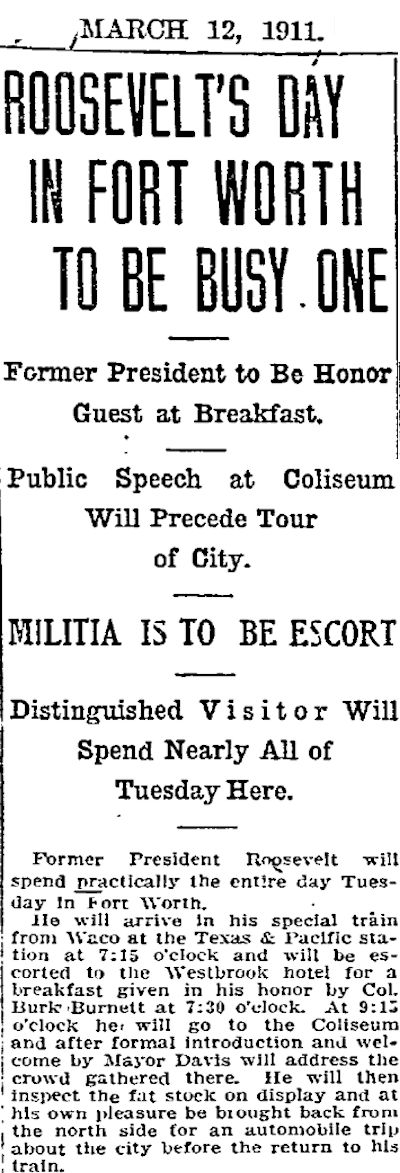 Ex-President Teddy Roosevelt visited in 1911.
Ex-President Teddy Roosevelt visited in 1911.
Who was Cowtown’s next Roosevelt?
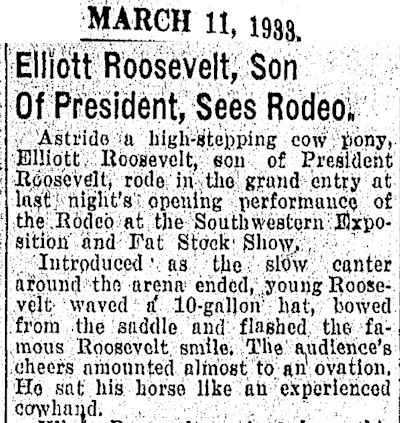 In 1910, just before Franklin Delano Roosevelt was elected to the New York State Senate, wife Eleanor gave birth to son Elliott. In March 1933 FDR had just taken office as president when Fort Worth’s stock show invited Elliott to visit the stock show. He not only visited but also rode in the grand entry on opening night. While here Elliott met socialite Ruth Googins, daughter of Swift packing plant manager Joseph B. Googins of 1101 Penn Street on Quality Hill.
In 1910, just before Franklin Delano Roosevelt was elected to the New York State Senate, wife Eleanor gave birth to son Elliott. In March 1933 FDR had just taken office as president when Fort Worth’s stock show invited Elliott to visit the stock show. He not only visited but also rode in the grand entry on opening night. While here Elliott met socialite Ruth Googins, daughter of Swift packing plant manager Joseph B. Googins of 1101 Penn Street on Quality Hill.
Did sparks fly?
Yes, they did.
Was Elliott married at the time?
Yes, he was.
Uh-oh.
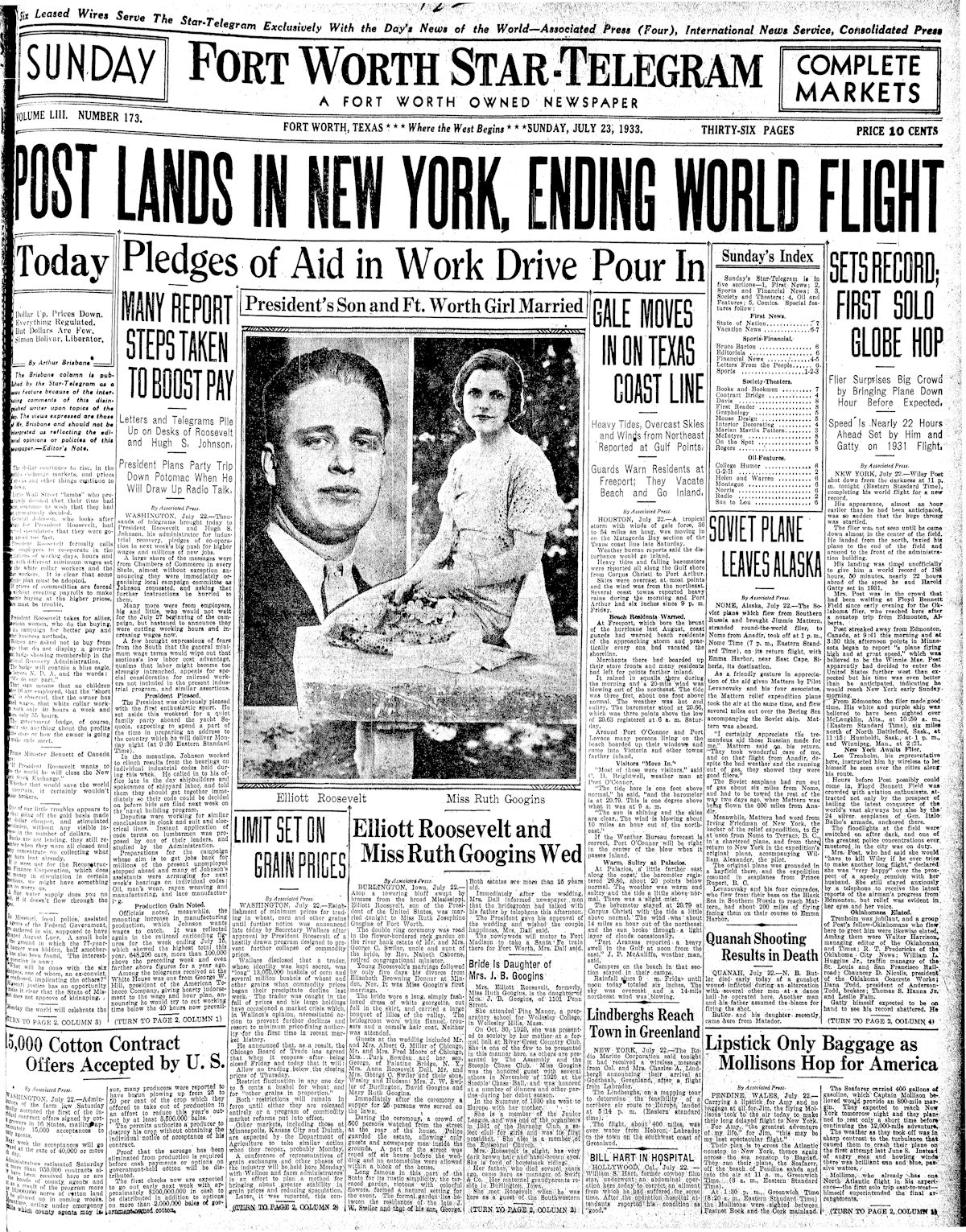 Later in 1933, five days after Elliott and his wife were granted a divorce, Ruth and Roosevelt were married.
Later in 1933, five days after Elliott and his wife were granted a divorce, Ruth and Roosevelt were married.

Ruth and Elliott Roosevelt posed at her parents’ home in 1933. (Photo from University of Texas at Arlington Libraries.)
By 1935 Elliott and Ruth were living at their 1,300-acre Dutch Branch ranch in Benbrook. The Roosevelts raised cattle and horses.
What did Elliott Roosevelt do for a living?
The president’s son became a radio executive after moving to Fort Worth.
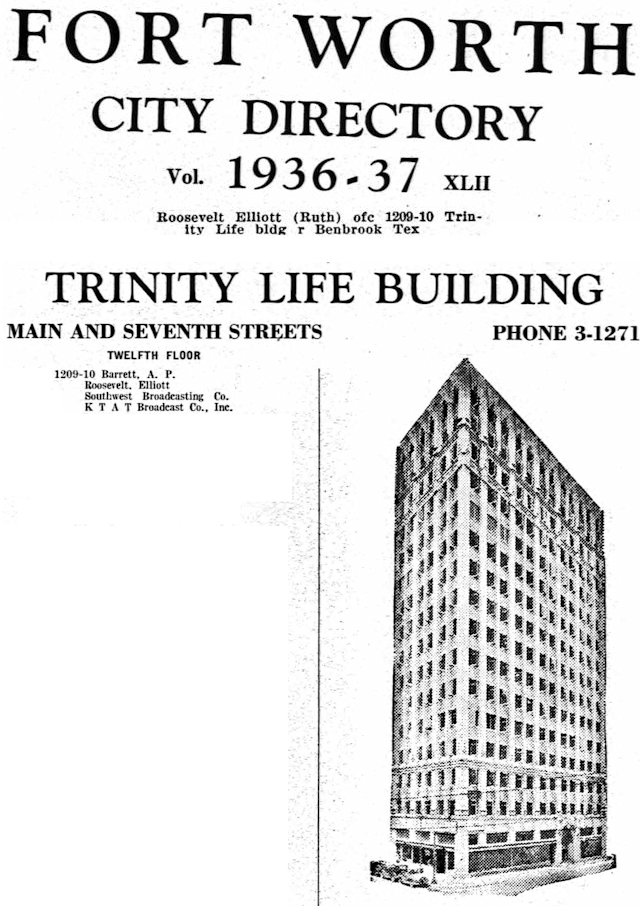
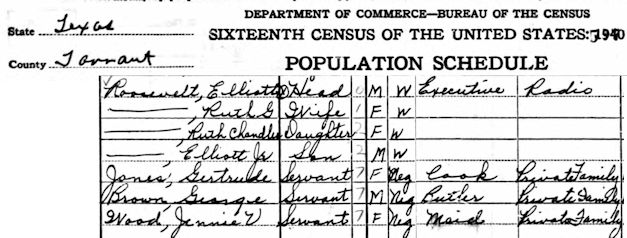 Elliott was an executive of A. P. Barrett‘s Southwest Broadcasting Company. The company’s office was in the Trinity Life Building, which Barrett had built as the “Aviation Building.”
Elliott was an executive of A. P. Barrett‘s Southwest Broadcasting Company. The company’s office was in the Trinity Life Building, which Barrett had built as the “Aviation Building.”
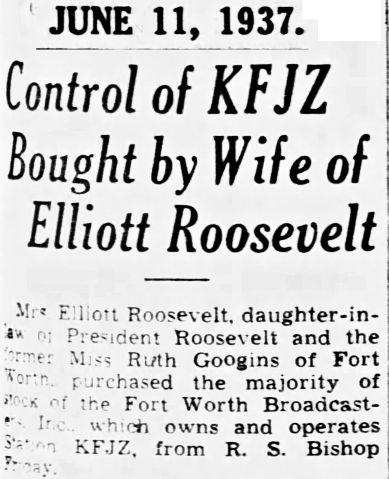 In 1937 Ruth Googins Roosevelt gained control of the company that owned radio station KFJZ.
In 1937 Ruth Googins Roosevelt gained control of the company that owned radio station KFJZ.
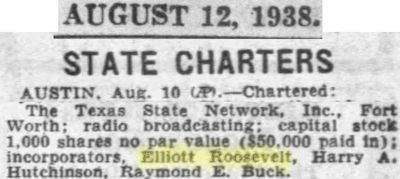
 In 1938 Elliott Roosevelt formed the twenty-three-station Texas State Network, an affiliate of the Mutual Broadcasting System. Radio station KFJZ became the new network’s flagship station. When TSN went on the air, Roosevelt emceed a celebration at the original Casa Manana featuring Bob Hope, Gene Autry, and Governor James Allred.
In 1938 Elliott Roosevelt formed the twenty-three-station Texas State Network, an affiliate of the Mutual Broadcasting System. Radio station KFJZ became the new network’s flagship station. When TSN went on the air, Roosevelt emceed a celebration at the original Casa Manana featuring Bob Hope, Gene Autry, and Governor James Allred.
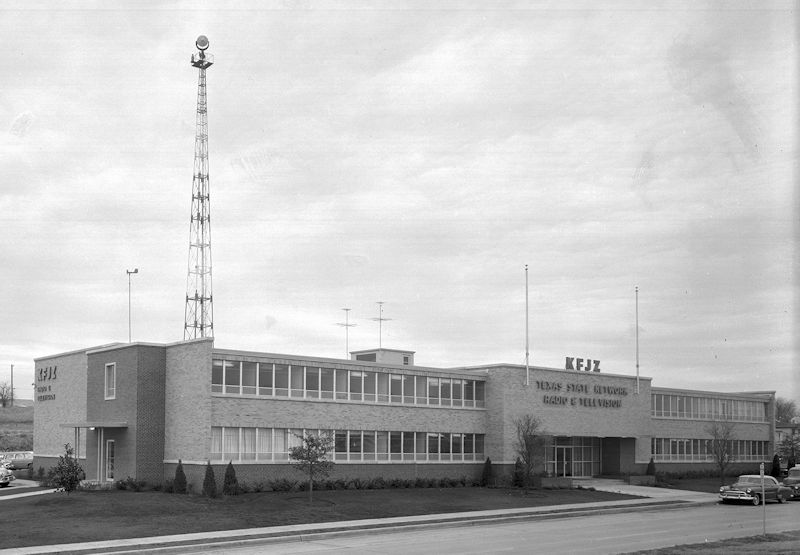
KFJZ radio’s studio was at 1201 West Lancaster Avenue from 1938 to 1955. KFJZ radio moved to a new building (pictured) on the West Freeway in 1955 as KFJZ-TV began broadcasting. (Photo from University of Texas at Arlington Libraries W. D. Smith Commercial Photography Collection.)
What was the maiden name of Elliott’s mother, Eleanor Roosevelt?
“Roosevelt.”
Say again?
Anna Eleanor Roosevelt and Franklin Delano Roosevelt were fifth cousins once removed. Franklin Delano Roosevelt and Teddy Roosevelt were fifth cousins. Eleanor Roosevelt was Teddy’s niece.
How many times did Eleanor Roosevelt visit Fort Worth?
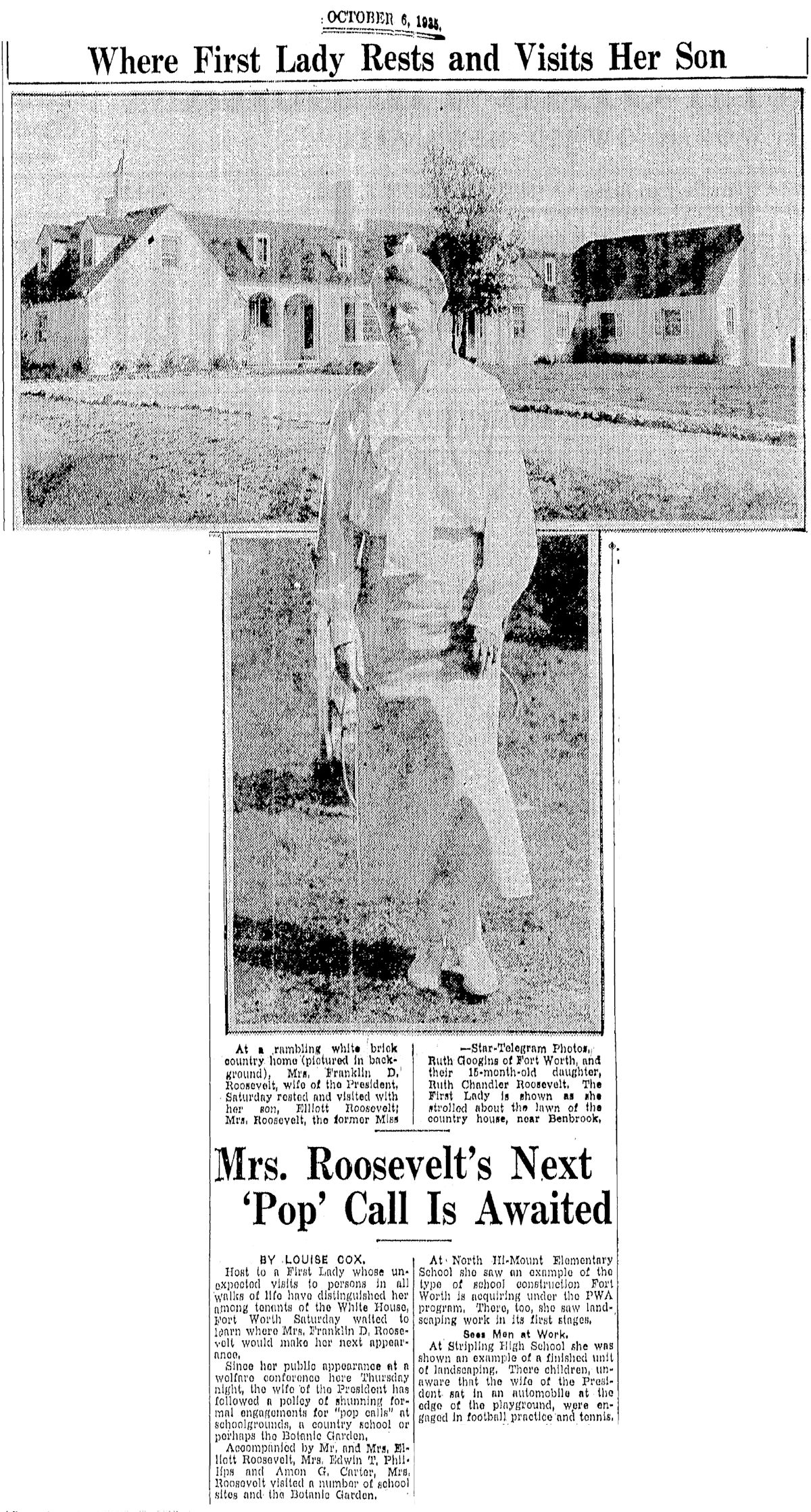 Beaucoup. Eleanor Roosevelt visited Fort Worth when her husband did, but she also made solo trips to Fort Worth. Whether traveling together or individually, FDR and Eleanor always visited Elliott and Ruth at Dutch Branch ranch.
Beaucoup. Eleanor Roosevelt visited Fort Worth when her husband did, but she also made solo trips to Fort Worth. Whether traveling together or individually, FDR and Eleanor always visited Elliott and Ruth at Dutch Branch ranch.
Eleanor Roosevelt became famous for her “pop calls.” While here in 1935 she popped in on Stripling and North Hi Mount schools and, accompanied by Amon Carter, Botanic Garden.
Eleanor was interested in public works projects, and both schools and the garden were built or landscaped by the federal Works Progress Administration.
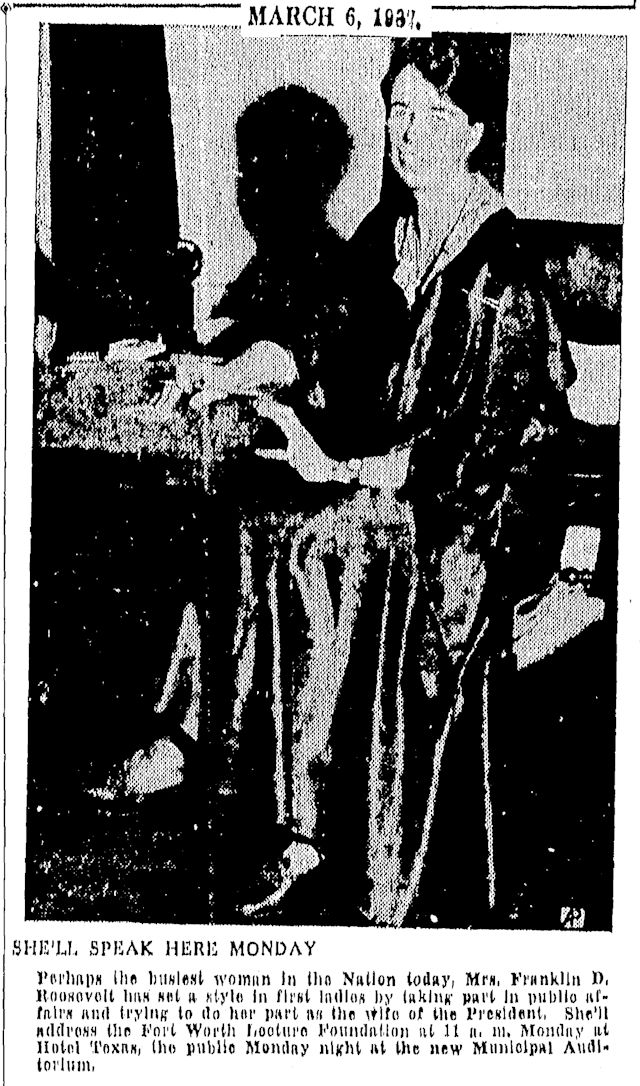 Eleanor was back in 1937 to deliver two speeches.
Eleanor was back in 1937 to deliver two speeches.
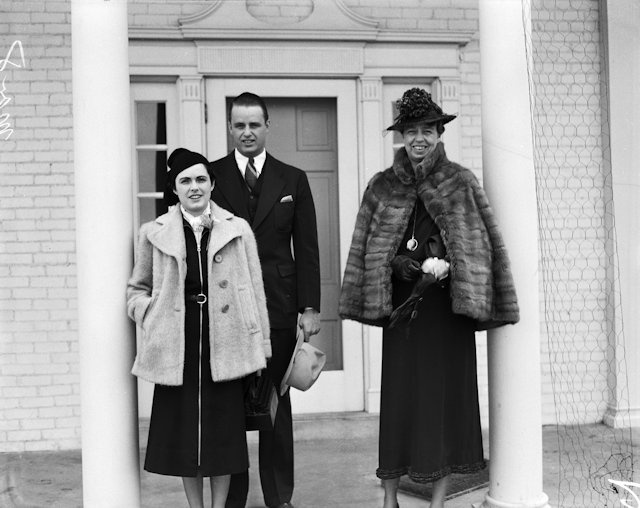
Eleanor Roosevelt with son Elliott and daughter-in-law Ruth at Dutch Branch ranch in 1937. (Photo from University of Texas at Arlington Library.)
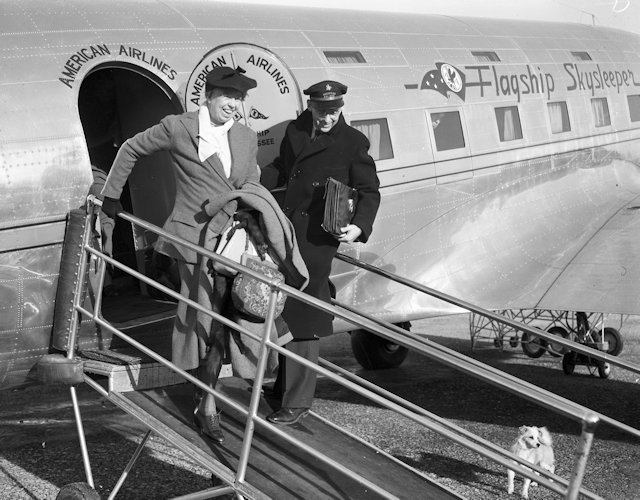
Eleanor Roosevelt arrives at Meacham Field to visit Elliott and Ruth in 1938. (Photo from University of Texas at Arlington Library.)
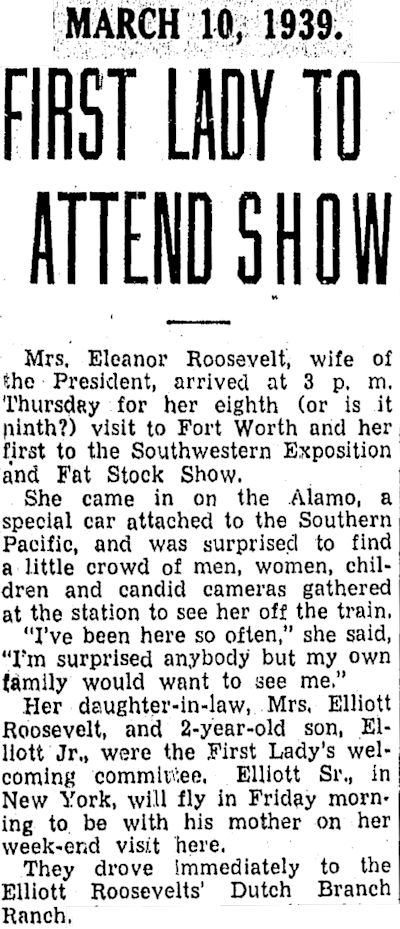 By 1939 the Star-Telegram seemed uncertain how many times Eleanor had been to the stock show: eight or nine. Mrs. Roosevelt said, “I’ve been here so often, I’m surprised anyone but my own family would want to see me.”
By 1939 the Star-Telegram seemed uncertain how many times Eleanor had been to the stock show: eight or nine. Mrs. Roosevelt said, “I’ve been here so often, I’m surprised anyone but my own family would want to see me.”
How many times did FDR visit Fort Worth?
Five times: 1936, 1937, 1938, 1942, and 1943.
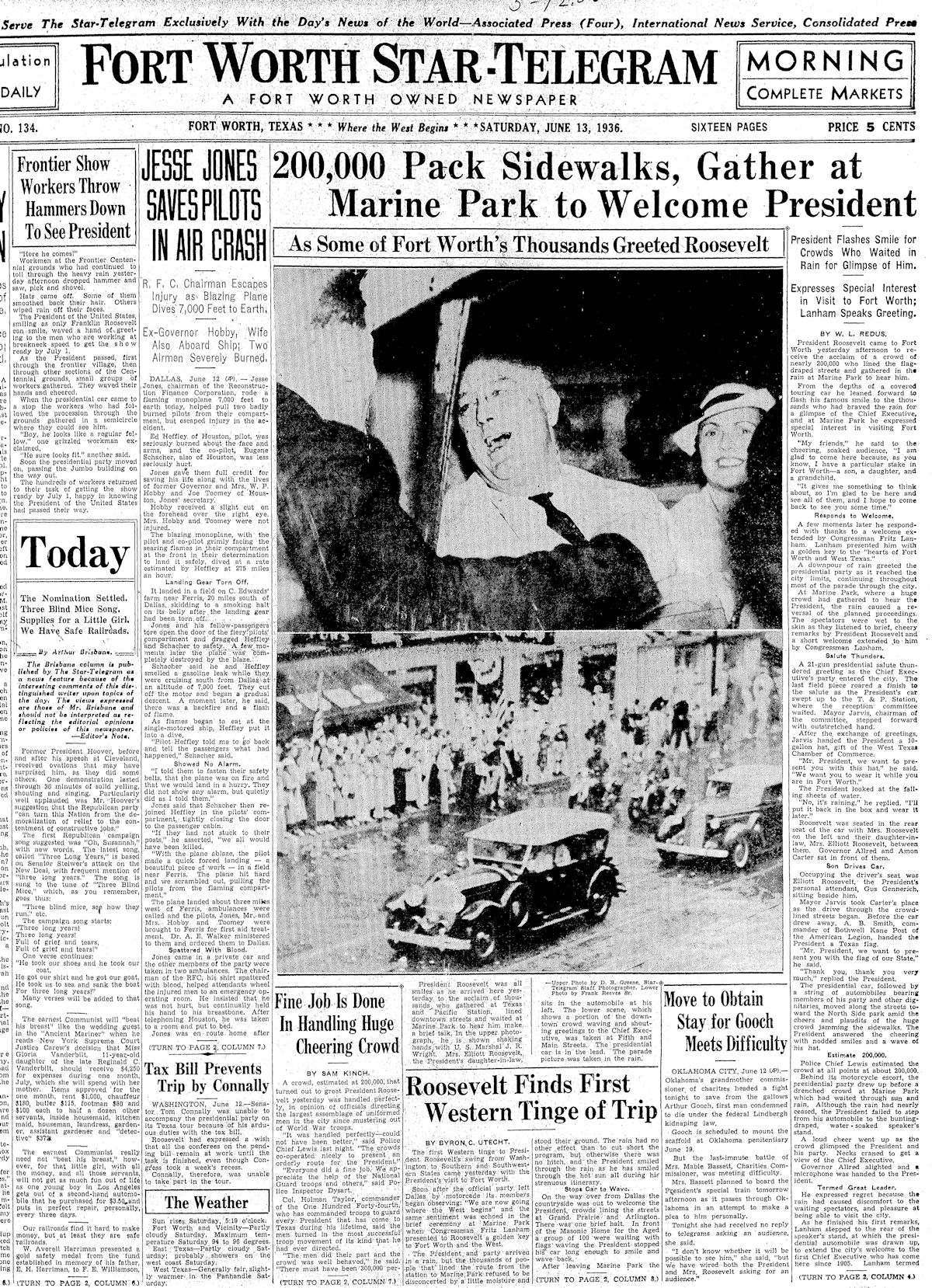
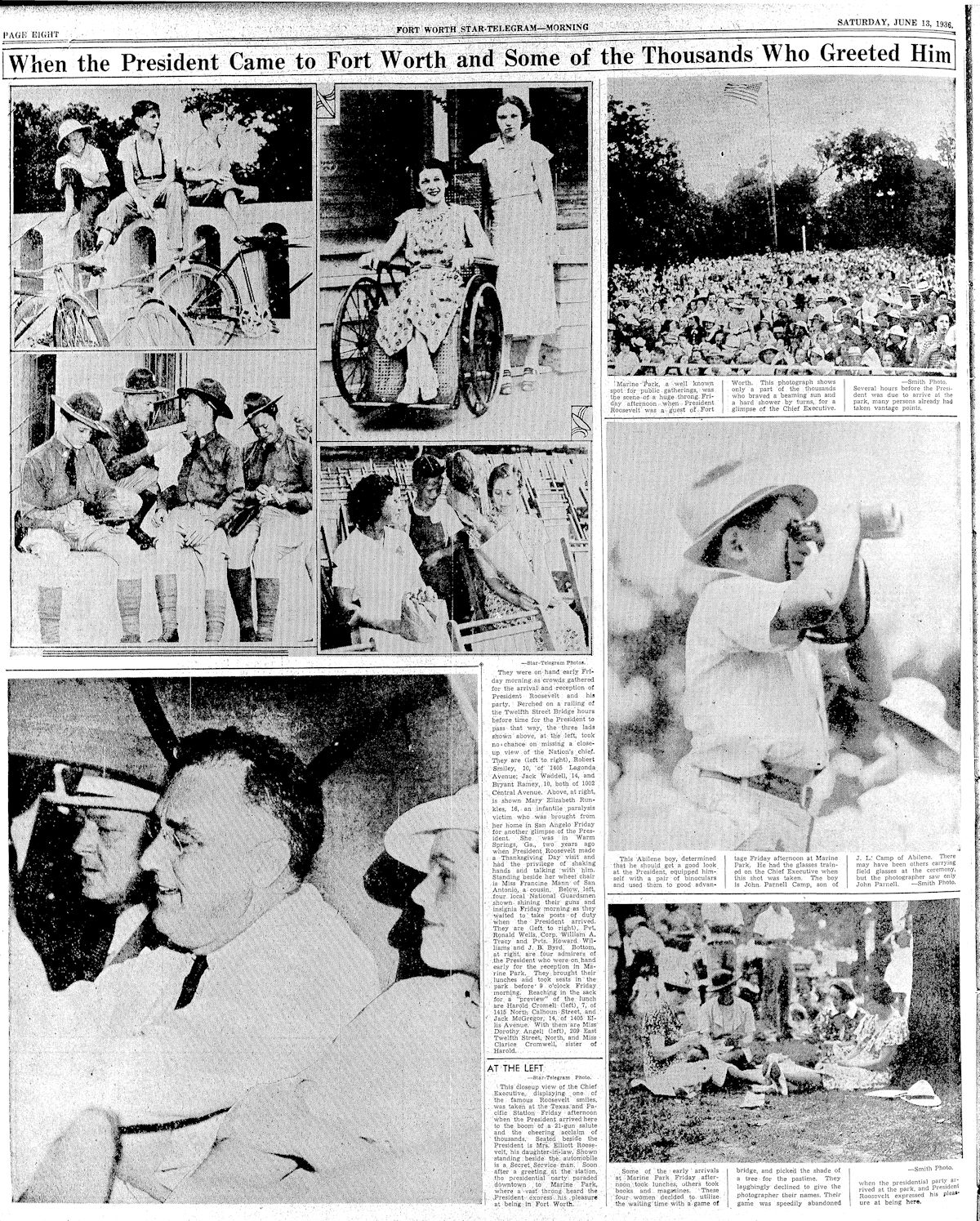 In 1936, despite the rain, thousands of people lined the route of FDR’s car as he was driven to Fort Worth from Dallas. He was greeted at Fort Worth’s Texas & Pacific passenger station by Mayor Van Zandt Jarvis and Amon Carter and given a ten-gallon hat.
In 1936, despite the rain, thousands of people lined the route of FDR’s car as he was driven to Fort Worth from Dallas. He was greeted at Fort Worth’s Texas & Pacific passenger station by Mayor Van Zandt Jarvis and Amon Carter and given a ten-gallon hat.
Then FDR was driven through downtown to Marine Park. (Marine Park is just southeast of what today is J. P. Elder Middle School. During the drive FDR’s daughter-in-law Ruth Googins Roosevelt sat beside him in the back seat. Amon Carter sat in the front seat.
At the park FDR was given a golden key to the city.
At the park Roosevelt addressed the crowd from his car using a microphone. He began his short speech with: “My friends, I am glad to come here today because, as you know, I have a particular stake in Fort Worth—a son, a daughter, and a grandchild. That gives me something to think about. And so I am glad to be here today to see all of them, and I hope to come back to see all of you again sometime soon.”
In the crowd, oblivious to the falling rain, was a girl in a wheelchair. Mary Elizabeth Runkles, sixteen, of San Angelo, had met FDR when both were being treated for paralysis in Warm Springs, Georgia. At Marine Park Eleanor Roosevelt recognized Mary Elizabeth in the crowd and called FDR’s attention to the girl. The Star-Telegram wrote, “Forgetting the speech that was being made, the crowd and the rain, he leaned toward the side of the car, clasped both hands above his head and shook them—at Mary Elizabeth.”
Escorted by Amon Carter, FDR then toured the grounds of the Frontier Centennial, which Roosevelt would officially open by remote control a month later.
From the centennial grounds FDR and entourage went to Dutch Branch ranch.
Police Chief Lewis estimated that the number of people who turned out to see FDR as he drove through Fort Worth and spoke at the park totaled 200,000.
In charge of National Guard troops called in to help Fort Worth police with crowd control was General John A. Hulen.
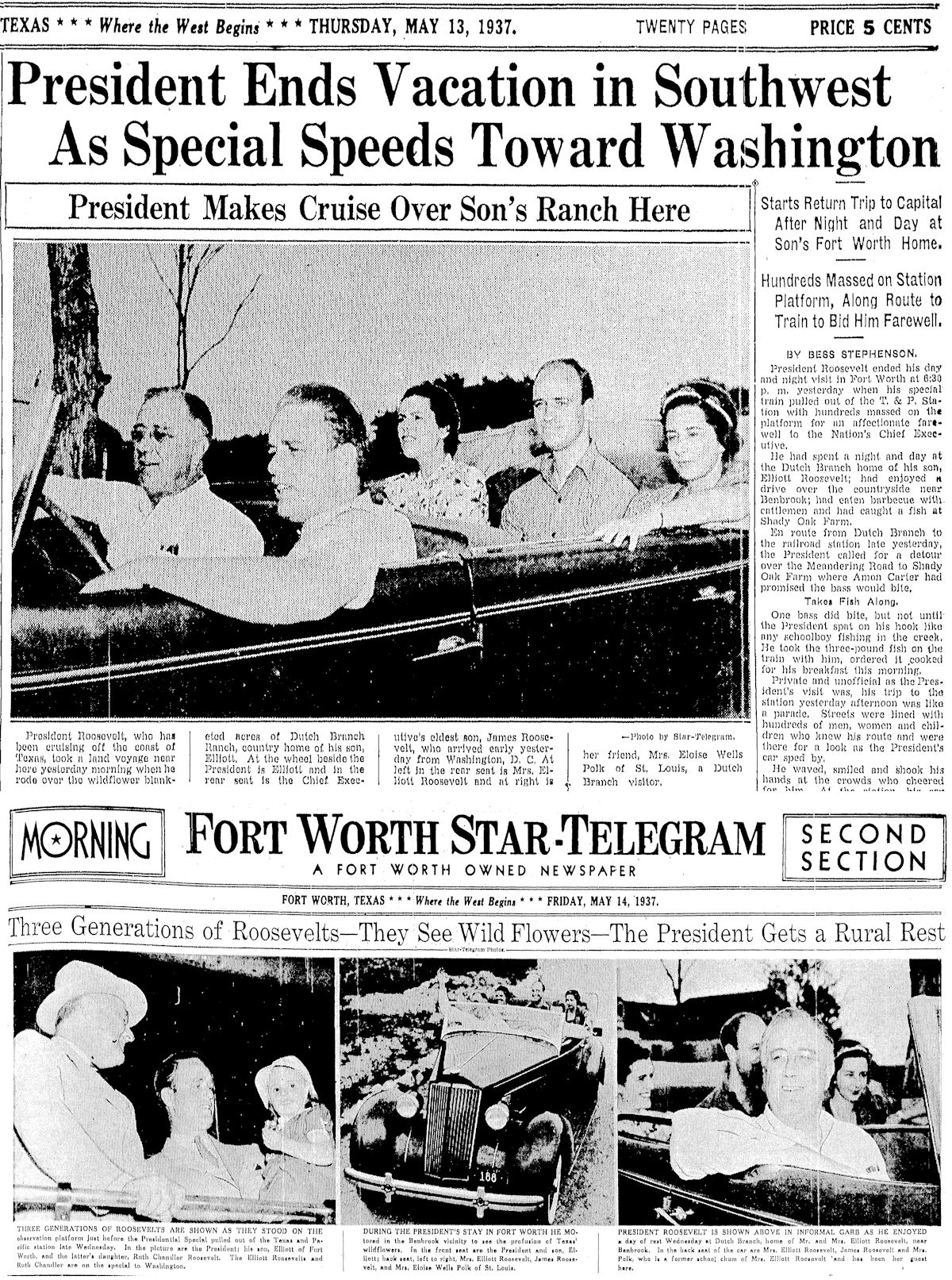 In 1937 FDR spent a day and a night at Dutch Branch ranch. He also visited Amon Carter’s Shady Oak Farm, where he fished for bass. The Star-Telegram reported that the leader of the free world caught a three-pound bass “but only after he spit on his hook like any schoolboy fishing in the creek.”
In 1937 FDR spent a day and a night at Dutch Branch ranch. He also visited Amon Carter’s Shady Oak Farm, where he fished for bass. The Star-Telegram reported that the leader of the free world caught a three-pound bass “but only after he spit on his hook like any schoolboy fishing in the creek.”
 In 1938 FDR again arrived by train on a speaking tour. Amon Carter headed the welcome delegation at the station. FDR stayed overnight at Dutch Branch ranch and gave a speech on KFJZ.
In 1938 FDR again arrived by train on a speaking tour. Amon Carter headed the welcome delegation at the station. FDR stayed overnight at Dutch Branch ranch and gave a speech on KFJZ.

President Roosevelt with son Elliott at the Texas & Pacific station in 1938. (Photo from University of Texas at Arlington Library.)
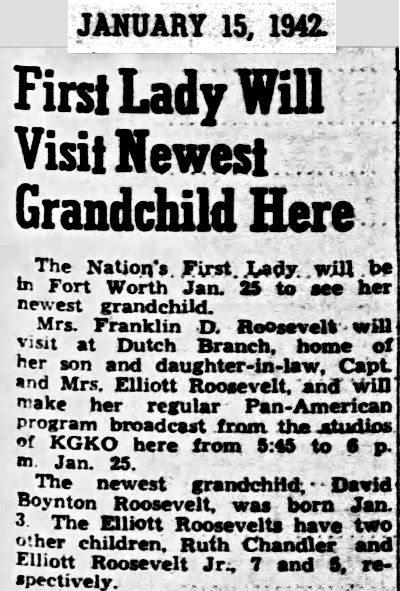 In January 1942 Mrs. Roosevelt returned to Dutch Branch ranch to see her new grandson. While in town she made a radio broadcast from station KGKO.
In January 1942 Mrs. Roosevelt returned to Dutch Branch ranch to see her new grandson. While in town she made a radio broadcast from station KGKO.
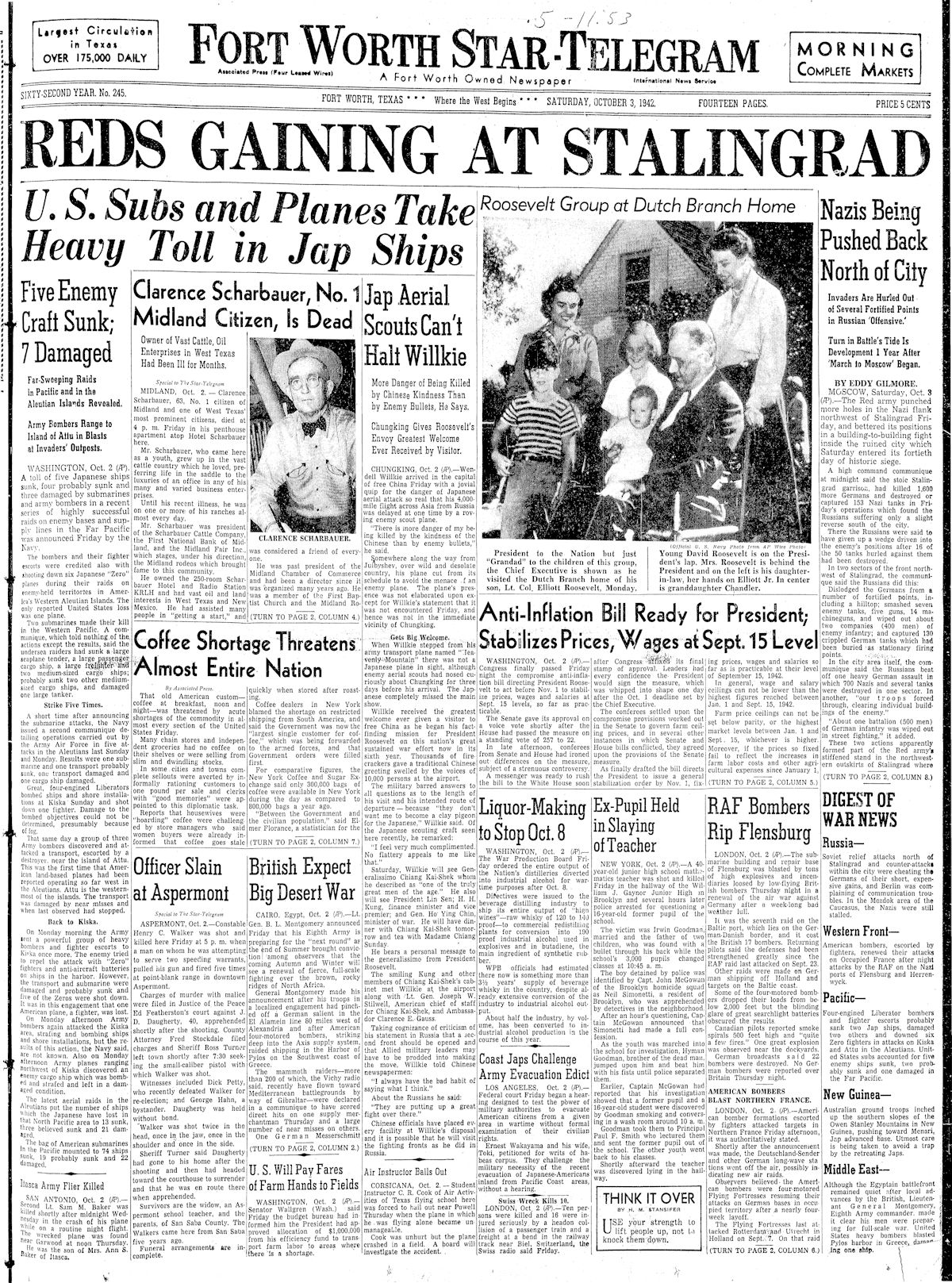 In 1942 FDR made a tour of defense plants, including Fort Worth’s Consolidated Aircraft bomber plant. He watched B-24s being assembled on the mile-long assembly line. George J. Newman, the plant’s vice president, said the exact length of the assembly line was restricted information. But he said, “Probably it is the longest straight assembly line in the country.”
In 1942 FDR made a tour of defense plants, including Fort Worth’s Consolidated Aircraft bomber plant. He watched B-24s being assembled on the mile-long assembly line. George J. Newman, the plant’s vice president, said the exact length of the assembly line was restricted information. But he said, “Probably it is the longest straight assembly line in the country.”
That’s because, according to Jerry Flemmons in Amon: The Life of Amon Carter, Sr. of Texas, Carter had asked FDR to make Consolidated’s plant in Fort Worth longer than Consolidated’s plant in Tulsa. Originally the two plants were to be identical.
While in town FDR also visited Dutch Branch ranch.
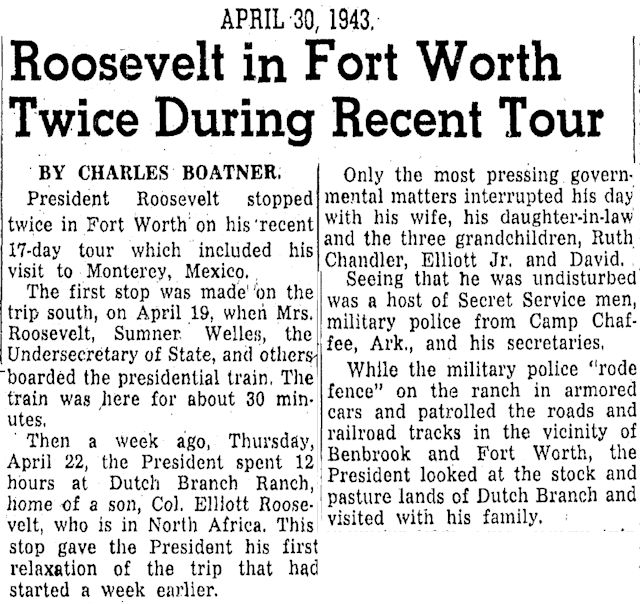 FDR again visited Dutch Branch ranch in 1943 while on another rail tour. His specially outfitted railroad coach was parked on a siding in Benbrook. Security at the ranch was tight during his visits. The Star-Telegram wrote that “military police ‘rode fence’ on the ranch in armored cars.”
FDR again visited Dutch Branch ranch in 1943 while on another rail tour. His specially outfitted railroad coach was parked on a siding in Benbrook. Security at the ranch was tight during his visits. The Star-Telegram wrote that “military police ‘rode fence’ on the ranch in armored cars.”
Why did Amon Carter seem to show up every time FDR and Eleanor came to town?
In the 1930s and 1940s—during FDR’s long presidency—Amon Carter was the face of Fort Worth to the rest of the world. He was also Fort Worth’s unofficial lobbyist with Washington. He and FDR were both Democrats and both well-to-do, although their backgrounds differed: Carter was a self-made son of the West; FDR was the scion of a patrician family of the East. The two men developed a pragmatic friendship. Thus, Carter escorted FDR when the president was in town, hosted the Roosevelts at his Shady Oak Farm or his suite at the Fort Worth Club. In turn, Carter visited the Roosevelts in the White House. Carter’s daughter Ruth took part in the Easter egg roll at the White House in 1934. Carter wrote the Roosevelts’ private telephone number in his address book.
Carter lobbied FDR on behalf of Fort Worth for projects such as the Frontier Centennial, Will Rogers complex, and the bomber plant.
Jerry Flemmons writes that Carter even had lent Elliott Roosevelt money to marry Ruth Googins and tried to shield the Roosevelts and Googinses from the media during the scandal that Ruth and Elliott’s entanglement caused.
What became of Ruth and Elliott?
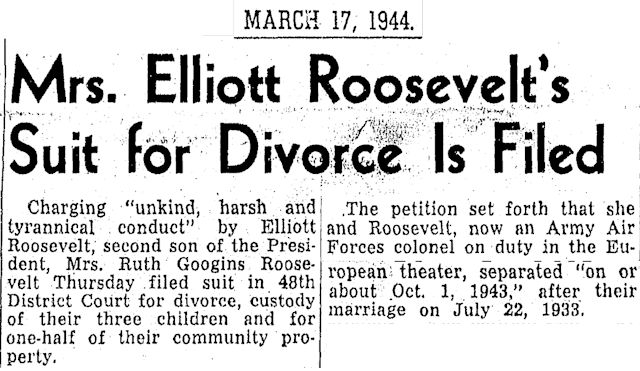 In 1944 Ruth divorced Elliott, then serving overseas in the Army. Both remarried: Ruth to an Army colonel, Elliott to actress Faye Emerson.
In 1944 Ruth divorced Elliott, then serving overseas in the Army. Both remarried: Ruth to an Army colonel, Elliott to actress Faye Emerson.
Was Faye Emerson his last wife?
Third of five.
What became of Dutch Branch ranch after the divorce?
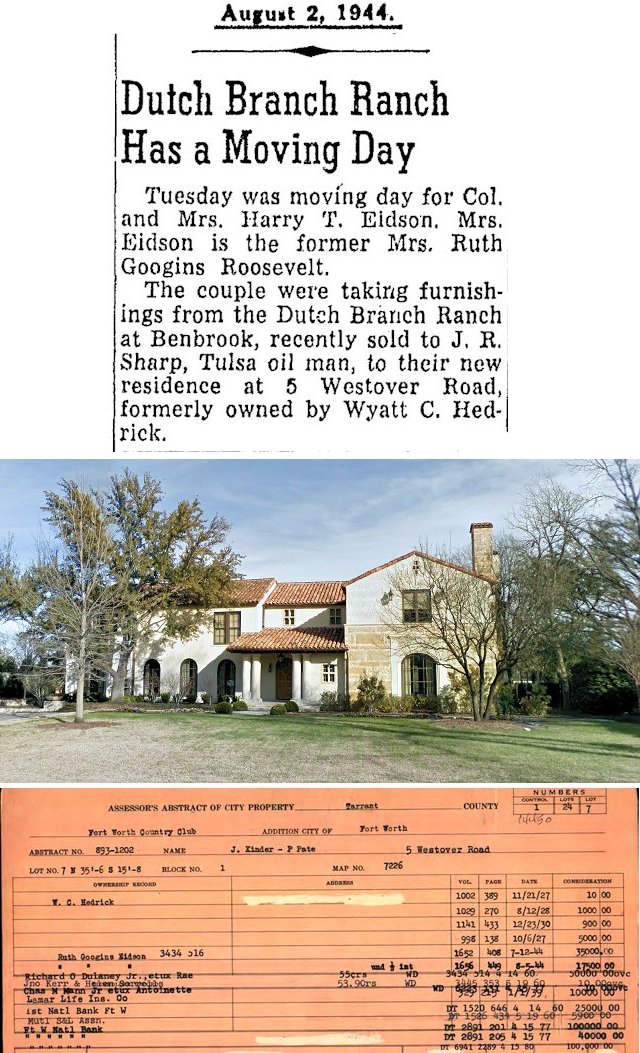 In 1944 a Tulsa oilman bought the ranch. Two years later oilman Sid Richardson bought it.
In 1944 a Tulsa oilman bought the ranch. Two years later oilman Sid Richardson bought it.
Where was Dutch Branch ranch located?
 The ranch was named because of its proximity to Dutch Branch creek, whose confluence with the Clear Fork of the Trinity River disappeared when the Clear Fork was impounded for Lake Benbrook. The lake also submerged at least part of the ranch. This map from the 1940s shows the area before the lake was impounded. The property of new owner J. R. Sharp of Tulsa is near the bottom. To the east is the track of the Fort Worth & Rio Grande railroad, which would have had a siding for the ranch. The map also shows the city of Benbrook, Benbrook Highway, the Texas & Pacific railroad tracks, and Dutch Branch and Bear creeks.
The ranch was named because of its proximity to Dutch Branch creek, whose confluence with the Clear Fork of the Trinity River disappeared when the Clear Fork was impounded for Lake Benbrook. The lake also submerged at least part of the ranch. This map from the 1940s shows the area before the lake was impounded. The property of new owner J. R. Sharp of Tulsa is near the bottom. To the east is the track of the Fort Worth & Rio Grande railroad, which would have had a siding for the ranch. The map also shows the city of Benbrook, Benbrook Highway, the Texas & Pacific railroad tracks, and Dutch Branch and Bear creeks.
Ruth Googins Eidson and Colonel Eidson moved into the house at 5 Westover Road, designed and built in 1928 by architect Wyatt Hedrick.
But Wyatt Cephas Hedrick is a whole ’nother question category for a whole ’nother episode of Cow—
[Clang! Clang! Clang!]
Dang that clang! Hear that, ladies and gentlemen? Yes, that obnoxious cowbell means our time is up for today. Tune in again soon for another episode of Cowtown Trivia.





